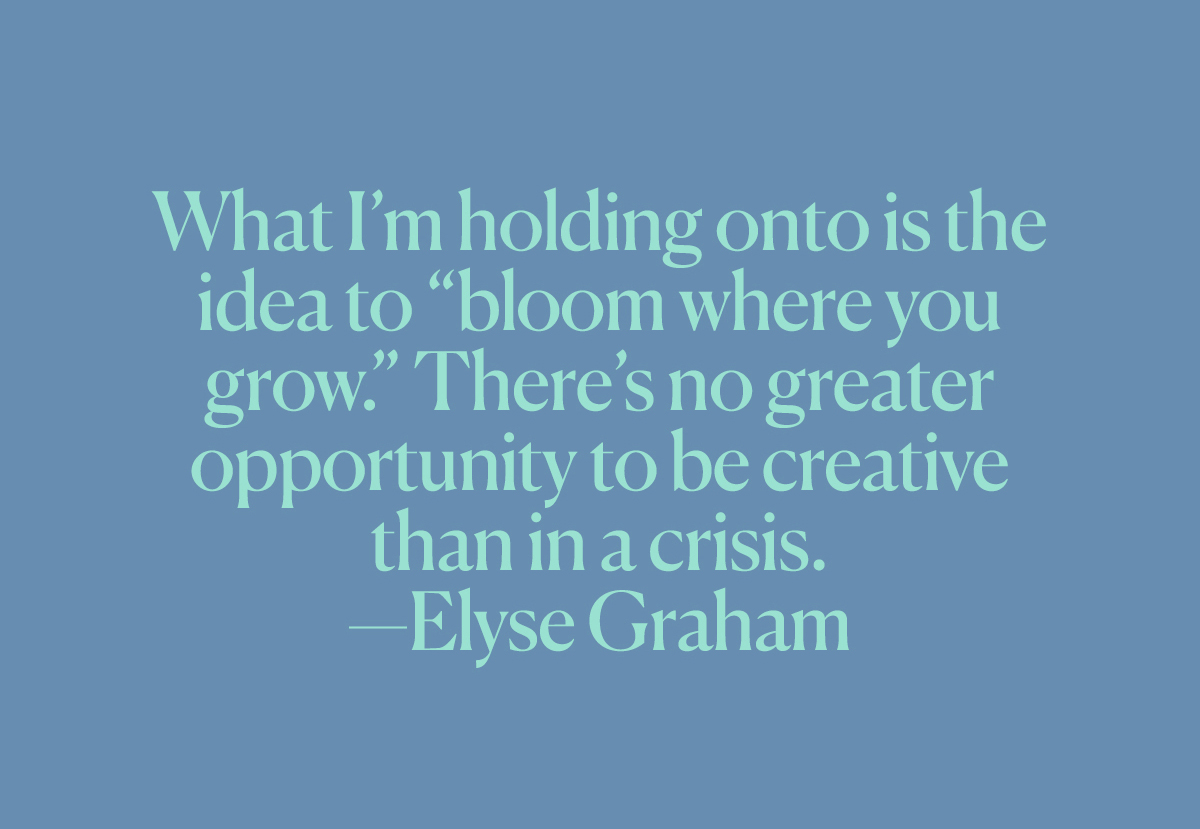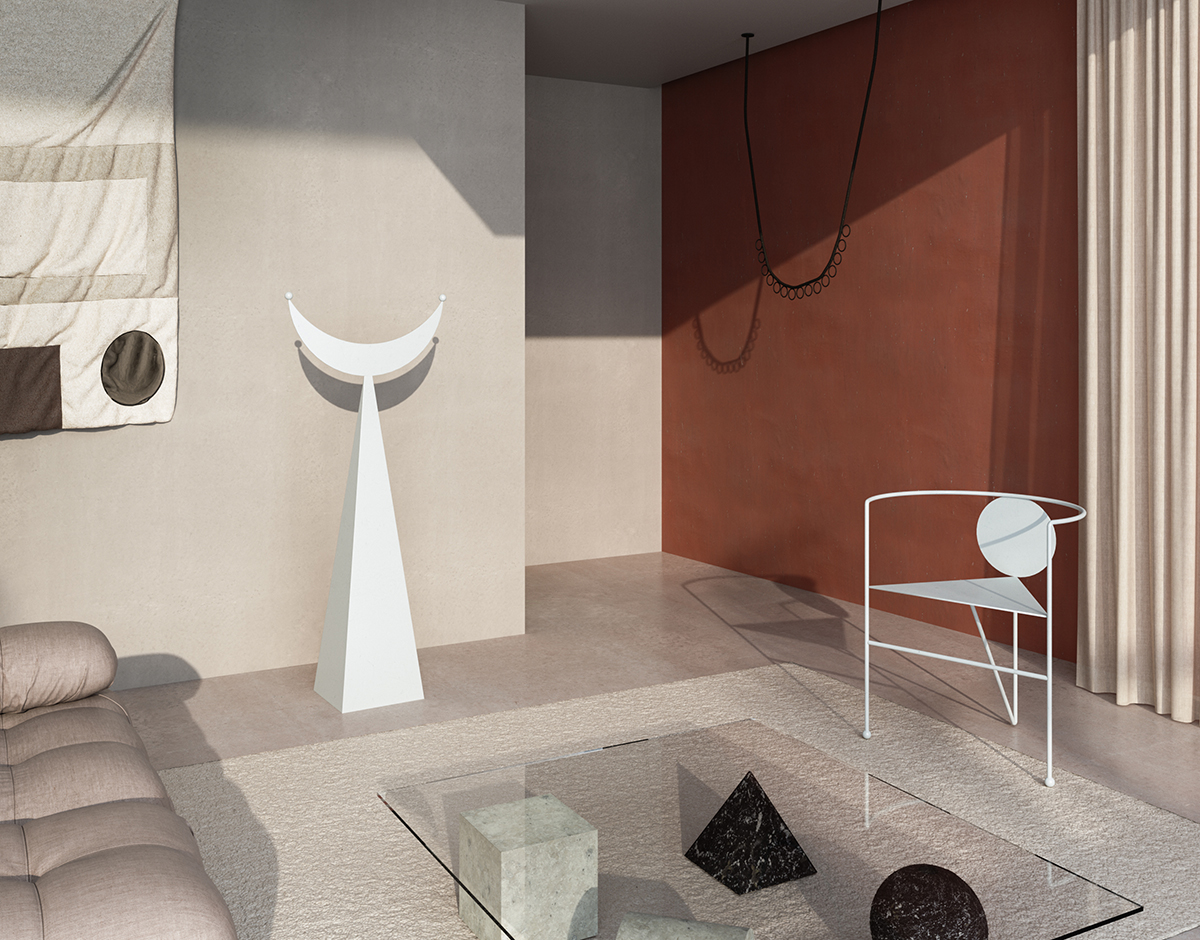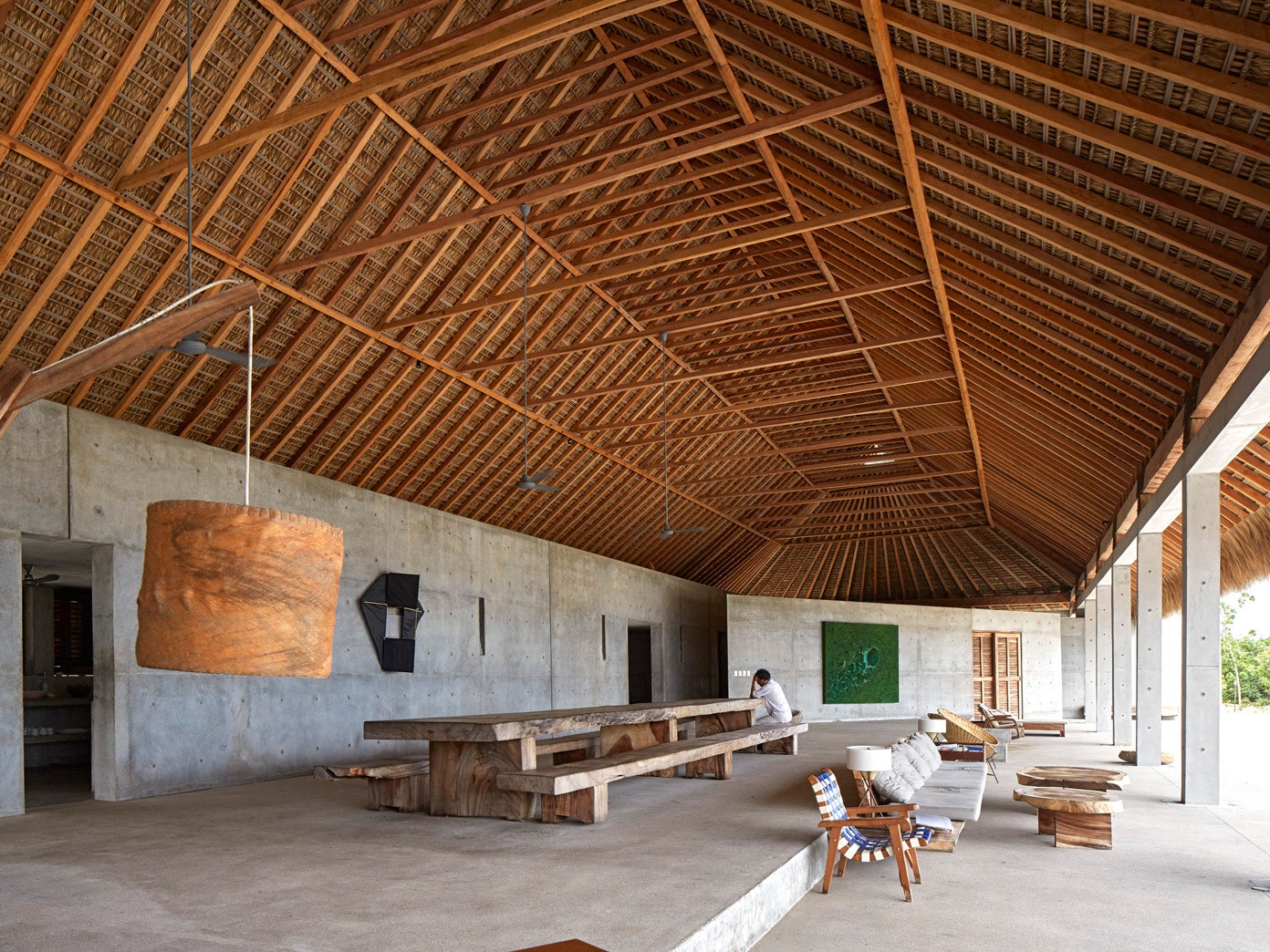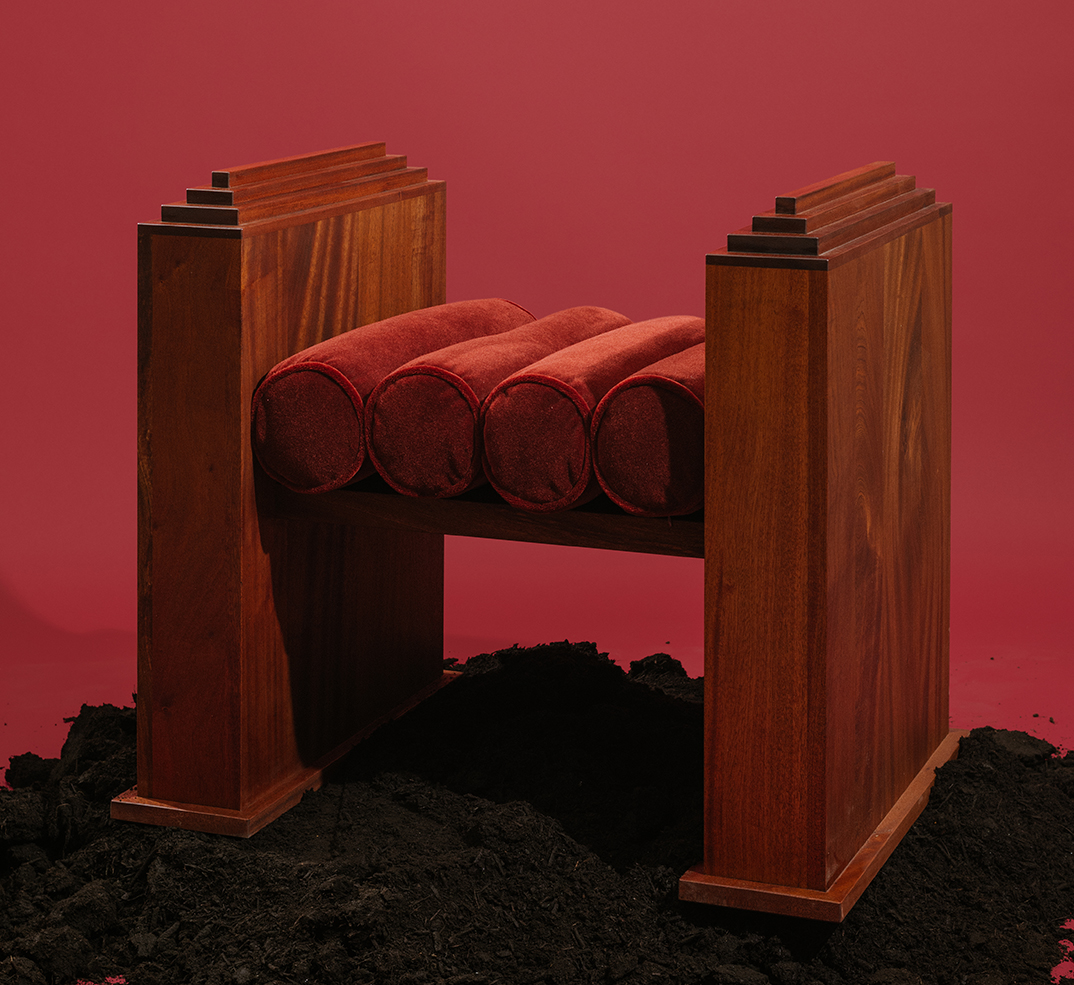
06.01.22
Up and Coming
Lesser Miracle’s Debut Solo Show is Fantastical and Deeply Felt
For some, a global pandemic was just the intervention they needed to change course or to finally give a latent vocation the opportunity to blossom. For Brooklyn-based art producer and sculptor-turned–furniture designer Vince Patti, a pandemic-enforced interlude of “being underemployed with a lot of time with my hands” — coupled with a newfound interest in the home environment — led him to escape more frequently to his Bed-Stuy studio, located in a creative hub that’s also populated by the fashion designers Telfar, Vaquera, and Bode, and furniture and interiors studio Green River Project. There, he began making side tables, dining tables, benches, and platform beds. “For whatever reason, my sculpture practice began to feel not particularly urgent or necessary,” Patti says. “I wasn’t as passionate about it as I once had been.” And so, out of necessity and boredom, he began to use the tools he already had on hand to make furniture. “I started posting it online, people started seeing it, and I started taking commissions from friends who, like me, were stuck at home. A lot of them were working from home for the first time; they were people who had traveled a lot and didn’t care about their apartments. That started to generate a furniture practice.”
One of the people Patti’s work hit a chord with was Mischa Langley, Patti’s now partner in furniture and life, who also began tinkering around with wood during the depths of the pandemic, posting the fruits of their labor on Instagram. Together, they formed the design practice Lesser Miracle, whose debut solo show at David Lewis’ home-cum-gallery in Chelsea is where we met for this interview on a sunny Sunday afternoon in May.
What began as a prompt from Lewis to make a “show of fantasy furniture” as a nod to their mutual interest in Dungeons & Dragons and Frank Frazetta’s sci-fi fantasy illustrations, turned into a collection of walnut and sapele furniture and lighting, inspired by otherworldly elements, yet deeply grounded in the domestic environment.
Fresh from an all-night dance party followed by an afternoon with friends at Prospect Park and a meal at Tom’s Diner, Patti and Langley, perched on a sapele daybed with intricate carving and cow hair Fortuny upholstery, talked about their influences, from tramp art to Dune, and how Langley’s personal transition provoked a meditation on immateriality that inspired them to dream up furniture for an alternate existence.
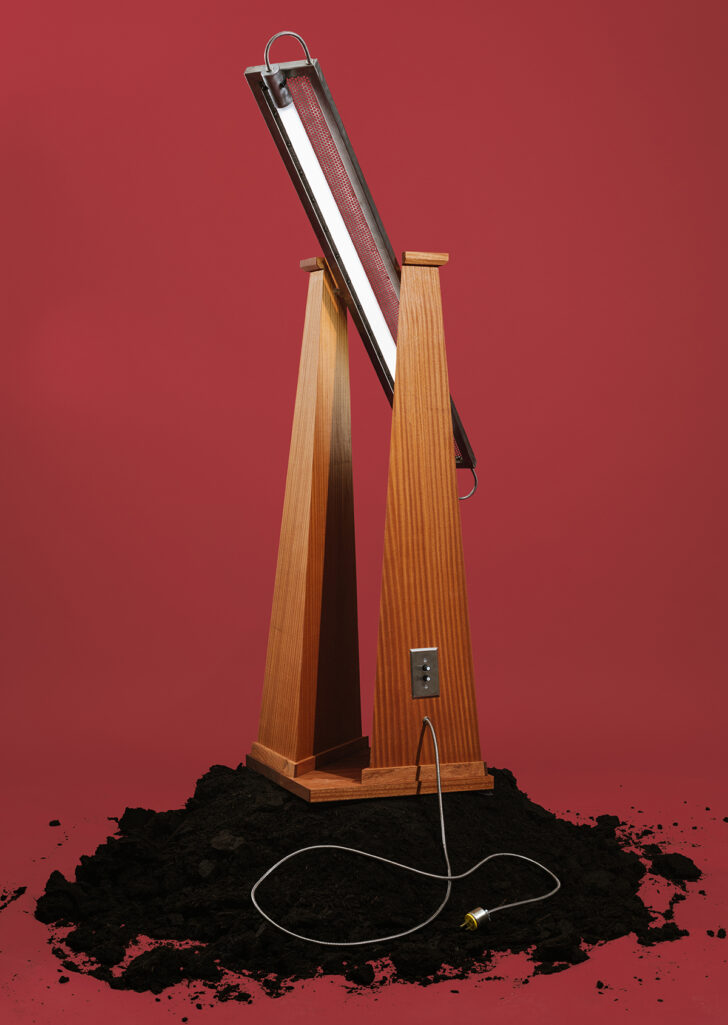
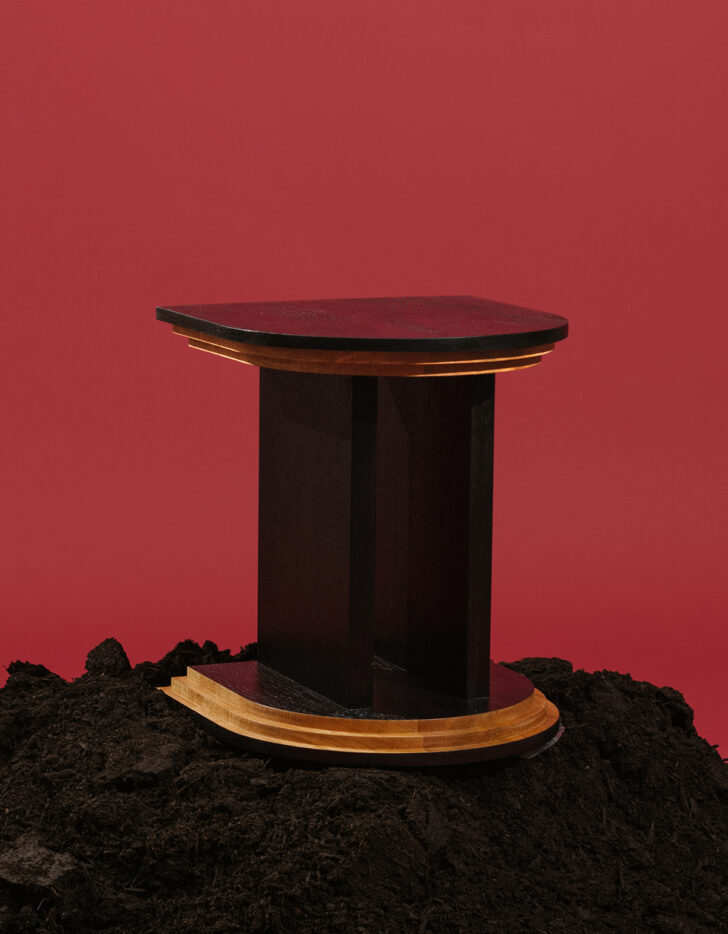
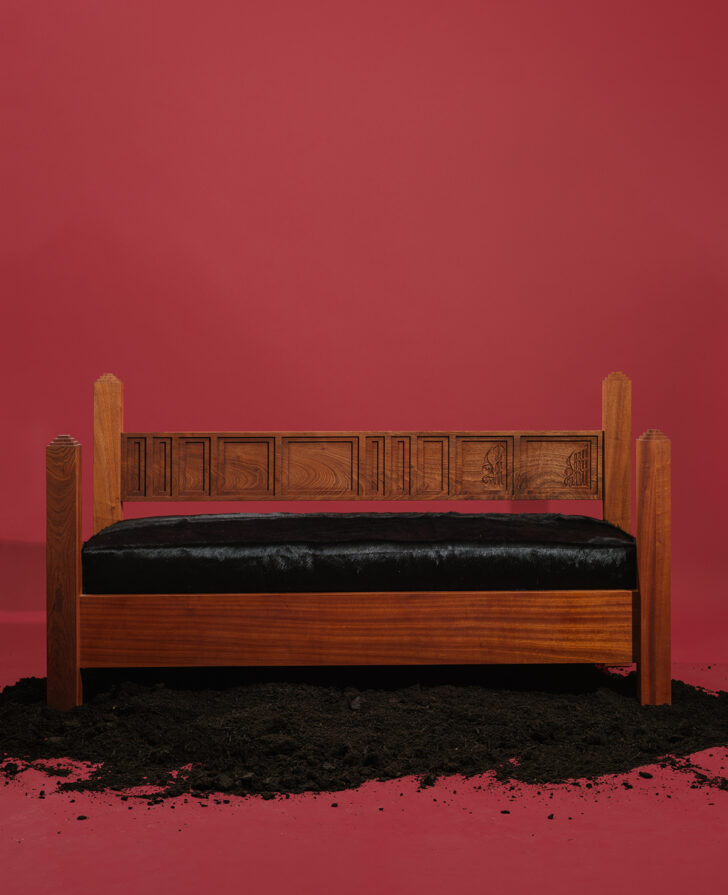
Vince, you have a sculpture background, and Mischa, you come from engineering. How did you connect, and what is the dynamic between you within this manifestation as Lesser Miracle?
Mischa Langley: [To Patti] You want me to talk about myself?
Vince Patti: Yeah. Yours is more interesting [laughs].
Mischa: I was, I mean I am, a mechanical engineer. It’s been a minute. I did my undergrad and then I moved to New York to do my master’s degree at NYU, mostly as an aerospace engineer. And I realized at one point that my research was being paid through DARPA [Defense Advanced Research Projects Agency]. The area of research I really liked, I didn’t want it to be used for weapons development, so I essentially couldn’t work in what I was passionate about. That occurred to me halfway through my master’s program. So I delved into applied math and I got a PhD offer. But the last semester it was COVID and I had one class and I was bored, so I went to the machine shop and made furniture for my new apartment. I was sharing it online and Vince and I have a lot of mutual friends and he saw it. I had some expertise with resin that he didn’t have, so we were going to work together on some pieces.
Vince: And that’s where the shared interest in furniture initially sparked what became the partnership. But for me, I’ve made furniture on and off on the side for friends and for myself ever since I’ve had a studio in Brooklyn. My background is mostly in the art world, either doing production management or studio assisting for artists, and making sculpture.
Mischa: Jobs started coming in, like Vince would get commissions that were too big for one person and we’d work on those together. And they just kept coming and coming and coming and then we were acting together.
What is it about furniture, specifically? Is it the scale? Is it the human connection? Is it more of the proximity to that domestic environment that made you both track in that direction?
Vince: I think it’s kind of all of the above, but for me, it’s usable sculpture, right? It’s like a sculpture that has constraints on it. And I think both of us, coming from a more art school background, that aspect of the assigned project where you are constrained is a very attractive prospect to a lot of people. And I think for you similarly, Mischa…
Mischa: Yeah. I guess I was accustomed to a lot of questions that have a right or wrong answer. It’s really open-ended to make a perfect sculpture because they could really be anything, but the perfect chair is like a pretty narrow box with a few defined axes. Constraints of form can generate beautiful work. Like some of the best poems are Haiku, which are so completely boxed in and they’re immaculate for that reason.
Was there anything, when you were thinking about your own spaces and building things for yourselves, that perhaps you weren’t seeing anywhere else, and that you wanted to create or put out in the world?
Vince: I think, at least for me, and this might be true for you too, Mischa. Creating your own world that doesn’t feel like a thing that you saw in a design magazine, that you were prescribed to like or be into or told was cool or was the thing of the moment, has always been very attractive to me. And for us, I think a lot of this collection is about really digging deep into a world of our own creation.
Mischa: And moving orthogonally to what is prescribed that we like—to be like perpendicular to that. I didn’t want a house full of “blobjects” and pastel colors.
I think another dimension of it too, is to be able to make something that you can tell was made [by hand] and you can see, if you know, how it was made and that it was well made and lovingly, is really satisfying. And that I think motivates the furniture—the apparent presence of the craft and the object.
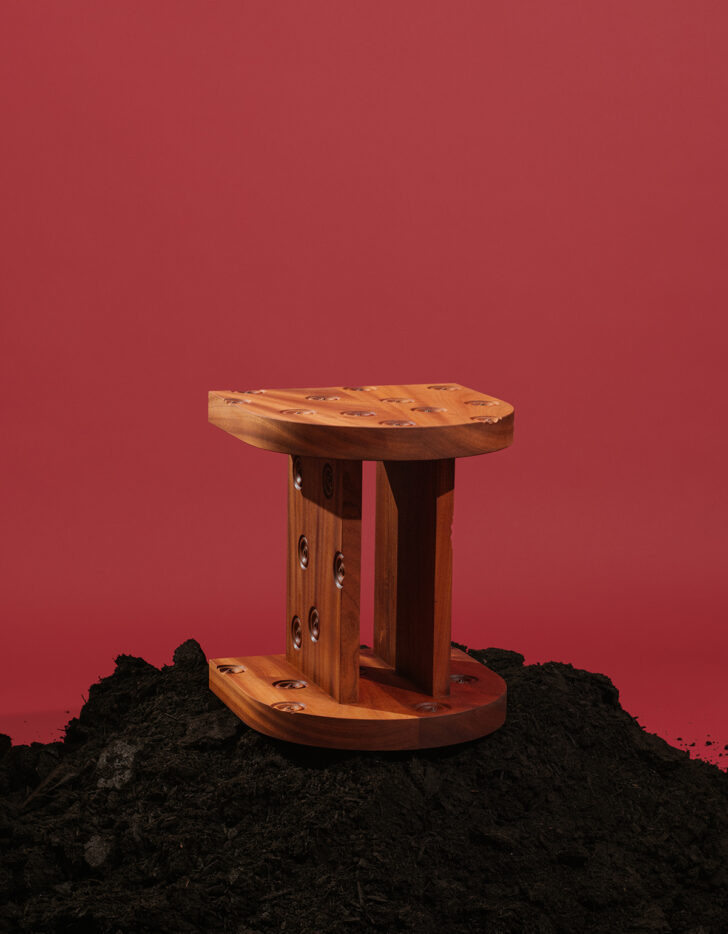
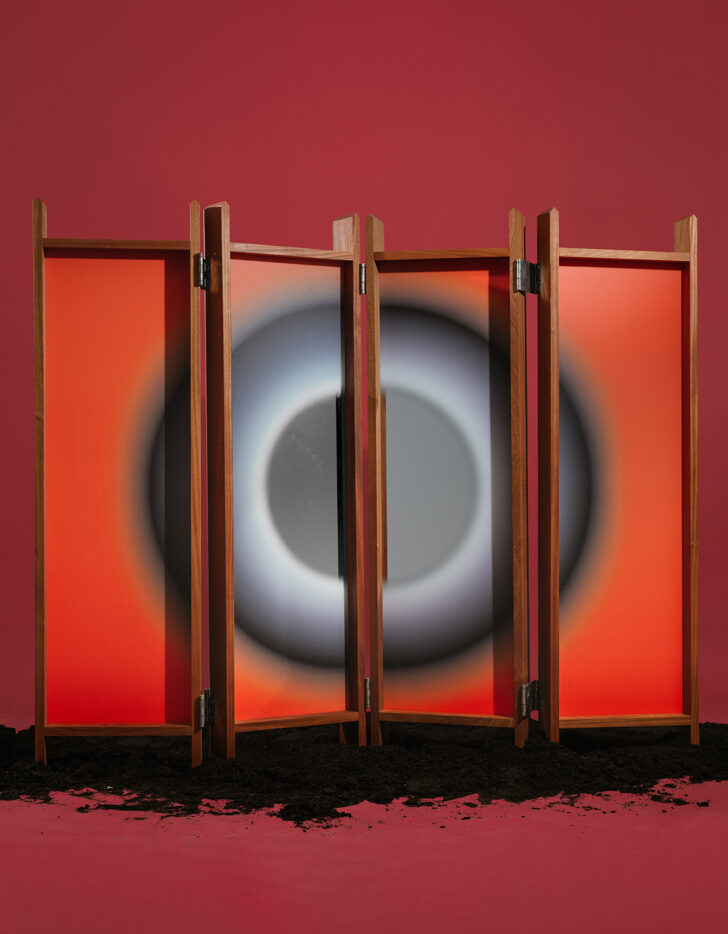
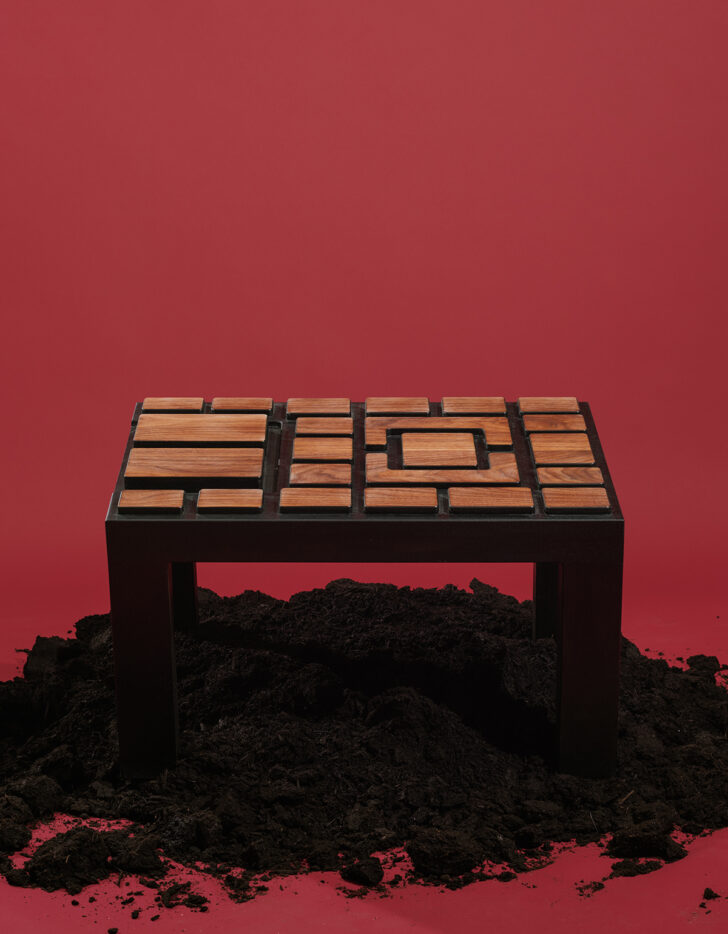
I imagine your background in engineering brings a functionality to the form as well, because there’s also a lot of people making furniture right now that actually, when you sit in it, you’re like, this is going to tip over…
Mischa: [Laughs] Yes. Sometimes when we come up with something really odd, I’ll do a structural analysis to make sure it won’t break. Like with these [Padishah Throne] chairs, this is kind of an odd shape, and the boxes are hollow and they’re framed on the inside. And I was like, Is this going to make too much of a bending moment where the legs will snap off the seat?
Vince: [Laughs] It’s really good having an engineer.
Do you think about these being forever pieces or heirloom pieces or the longevity of them?
Vince: Yeah. I think that’s something we’re both interested in, in terms of thinking about history and ancient cultures and traditions and ritual practice. Creating furniture that’s meant to be something that outlasts you is very attractive to both of us. And it’s very interesting.
Mischa: And thinking about references that are historical or deeply historical, just making something in this form where it suggests to you when you see it that it could be that old, helps tie it back into that reference. I think this group captures furniture for, like, the apartment of a brooding emperor or something.
Tell me more about those influences because I think that’s what makes this work so interesting. It’s ambiguous in the way that you can’t quite place the era or the provenance or the origin of it. I’m interested in what those influences are and how they intersect.
Mischa: A lot of our early conversations were around how it’s furniture that never existed or it’s furniture for like the vacation house of the Harkonnens from Dune. It’s like you could see where it could have left off from, but it’s for a culture that never existed. There’s a lot of ancient South and Central American influences in some of the pieces. We looked at a lot of medieval furniture and ancient Ottoman furniture and a lot of American tramp art.
I can see that in this mirror, which has a frame very reminiscent of tramp art.
Mischa: And a lot from English Brutalism, like the satisfaction of geometric repetition. These cells [points to the carving detail on the sapele daybed with cow hair upholstery] are in a Fibonacci sequence, in terms of dimension. But then the calligraphic detail is from the Alhambra, so in that way they’re put together.
And Fortuny fabrics!
Vince: Absolutely, yes, yes. Only the best. We were really pleased to get to work with them. This is one of our first forays into using a lot of upholstery and we were very fortunate that they were interested in working with us because they’re seemingly the last word in really great fabric.
And this is your first official collection in terms of a gallery show. How has it been for you—the experience of it and the response?
Mischa: I spent a lot of time thinking, it is just bizarre that my life is here. Like, one year ago this is the last place that I expected to be, but the response has been very kind, very generous. And it’s been really nice to hear people who are complete strangers come in and look at it and see immediately to the core of what I was thinking when I was making it without having to explain it to anyone, to pull someone in in that way. That’s really rewarding. I wouldn’t change a thing.
And will all of these pieces go into production in editions?
Vince: For the most part they’re editions—our standard edition number is 12. So these chairs, for instance, are a pair and there will be 12 pairs.
Mischa: Some of them are one of one, like this [points to The Wedding Gift laser cut walnut table]. Actually, you couldn’t pay me to make another one.
How so? Tell me more!
Mischa: It was just really difficult to finish and to assemble because this is a solid block of walnut. It was CNC’d into this shape, which is taken from an abacus. And after it got CNC’d, because there was so much material loss off the top, it really wanted to bow upwards. So I had to make this really complicated frame, and then fitting the legs on was a huge pain. And then I tried finishing it in so many ways and it never worked. I finished the whole thing black and I was like, I hate it. And I was trying to clean it off and I realized, if I just sanded the top, it would pull the wood out. I almost didn’t put it in, and then Vince talked me into it.
Vince: Some of our processes are often like that, where it’s experimental along the way. Certain pieces would be hard to recreate and fabricate at scale. And some of them, I think that’s what makes them really special, is that they’re more like an artwork and an exercise in experimentation.
Mischa: Like this one [The Wedding Gift] feels a lot more like sculpture. It’s not like I’m making a chair with fine woodworking, like a blueprint for how you make a chair. I was just trying things out.
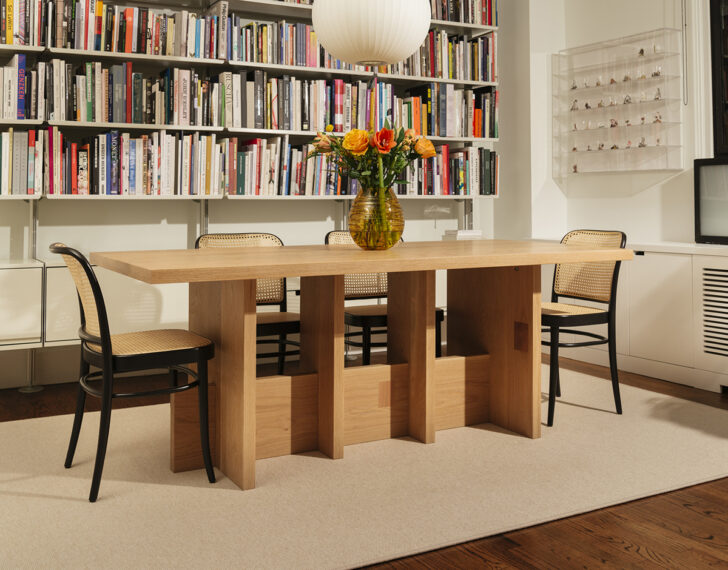
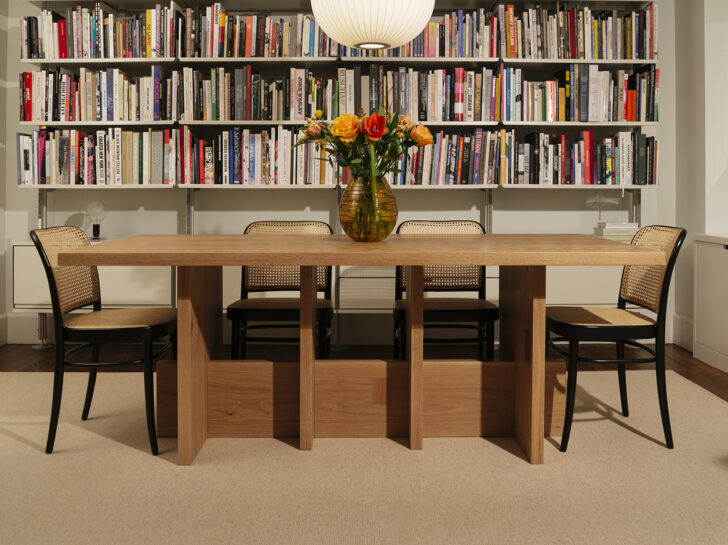
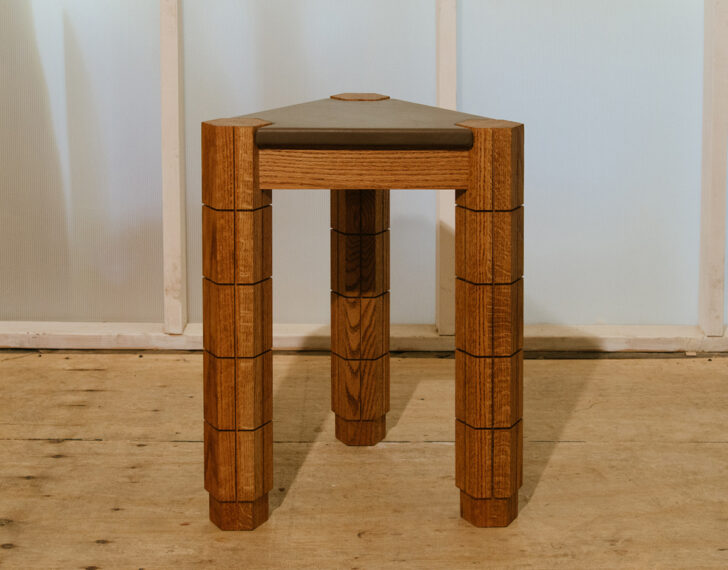
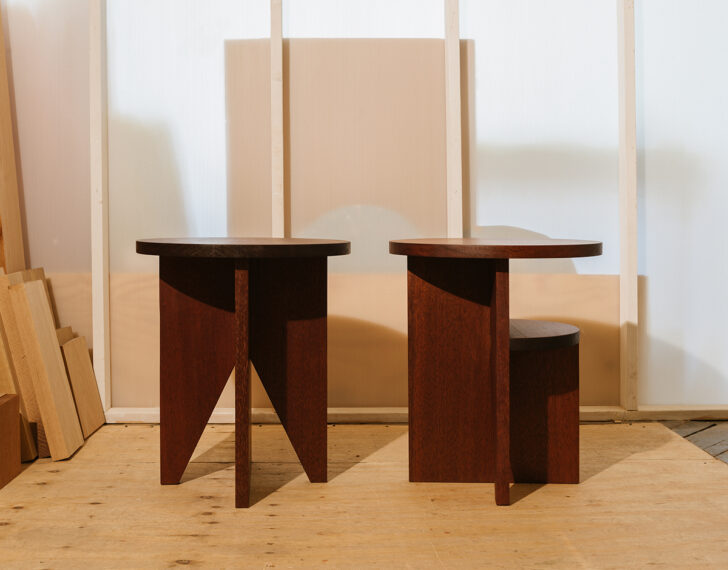
What’s your starting point? Do you do a lot of sketching? What does your studio look like?
Vince: Our studio at the moment is very geared towards fabrication because obviously we don’t have a ton of space. I pretty much made everything here in a space about the size of this room.
Mischa: We inhaled a lot of dust.
Vince: It was a labor. We spend a lot of time sketching on the computer. In my design school classes they taught us to be digitally native, so that’s where I feel very comfortable. But a lot of it also comes out of putting stuff together and thinking about forms.
Mischa: We work pretty differently. Vince will just pull something out of the air, whole cloth, and he’ll be like, I heard the muses while I was showering this morning: This is what I have to make. And I will know, I think maybe in a more engineering way, what I want to make. I will know what references I want to use. I will collect them. I will compartmentalize everything. And then I’ll proceed to drafting and making it.
You have a couple of lighting pieces in this collection. Is that new for you?
Vince: These are the first couple of pieces that we did. This one in particular [Windmill Lamp] was one I sketched and had almost no idea how to actually fabricate going in, which is pretty rare for us. And so this one, again, was a real labor of love because it took a lot more work and a lot more problem-solving than we thought.
Mischa: I would really love a new studio with more space to do my own metal work, but this one marked our first departure into doing metal work for a piece. We made everything on it. I wired the lamp. I ordered payphone cable. There’s not a blueprint for how we would make this thing again.
Vince: But, we would! [Laughs].
I love the height of it too. It’s an interesting in-between scale.
Vince: That was one thing we really liked about it. Because you could conceivably see this piece being quite a bit bigger or perhaps like a table size.
And the Prismatic Wall screen is a one of one?
Vince: Our graphic designers are also a queer couple who started a business during COVID. They’re called Ayem and they did our logo and our typeface. We knew them through friends and we knew we wanted to work with them when we were starting Lesser Miracle. And they had this lovely proposal to, instead of paying for services, create an object together. It was very kismet because we had both wanted to make a room divider screen.
Mischa: They gave us this beautiful graphic on four panels. And then Vince and I were like, Oh, what if we reutilize this frame motif we like? And what if we fade the graphic out to mirror so that it’s reflective?
Vince: It was a great collaboration and one we’re super happy with.
The name Lesser Miracle comes from Dungeons & Dragons. Tell me about that influence among everything.
Mischa: I just really like D&D and I think that’s a lot of what David [Lewis] and I originally hit it off over. This all wound up happening because I wore a tank top one day and he saw a tattoo I have by a fantasy illustrator he likes and we started talking about fantasy and he was like, “What if you did a show of fantasy furniture?” And so, this happened. but Lesser Miracle is an old spell and it’s the worst version of the spell Miracle, which is a spell for the priest class. You could feed the 5,000 or walk on water, and the idea of, okay, you can do something good, but like, don’t do too much. Like you can feed 500 people [laughs] or you could get really good at the butterfly stroke, but you can’t walk—that is just compelling. One day I was like, “Vince, we have to pick a name,” and I just started reading the names of spells I liked because a friend of mine makes knitwear and he uses the names of old Magic the Gathering cards. So I just started reading spell names and got to Lesser Miracle and was like, Yeah that’s it.
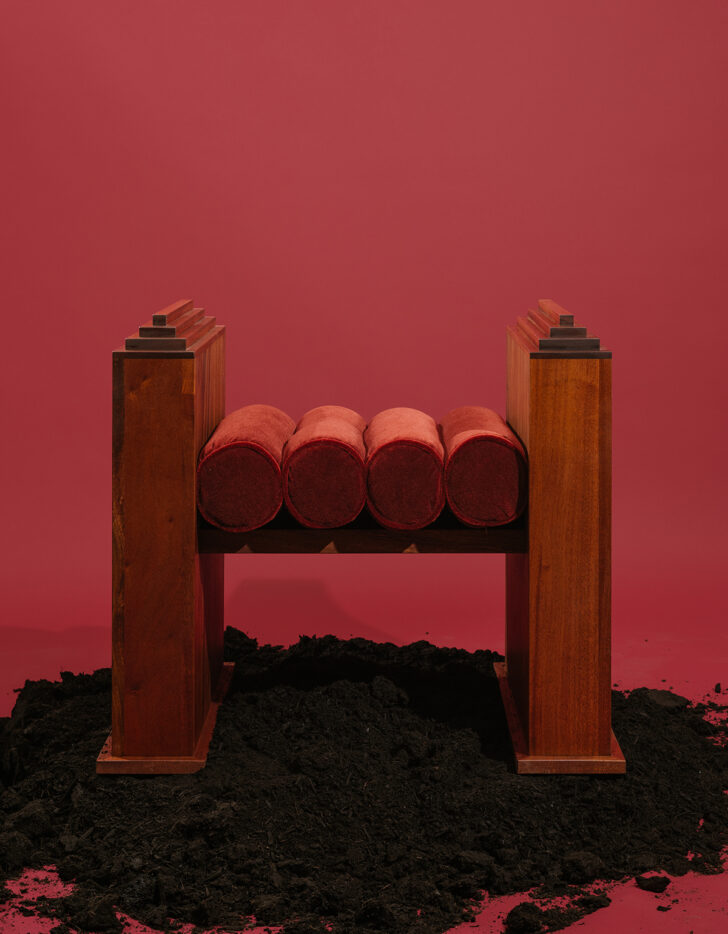
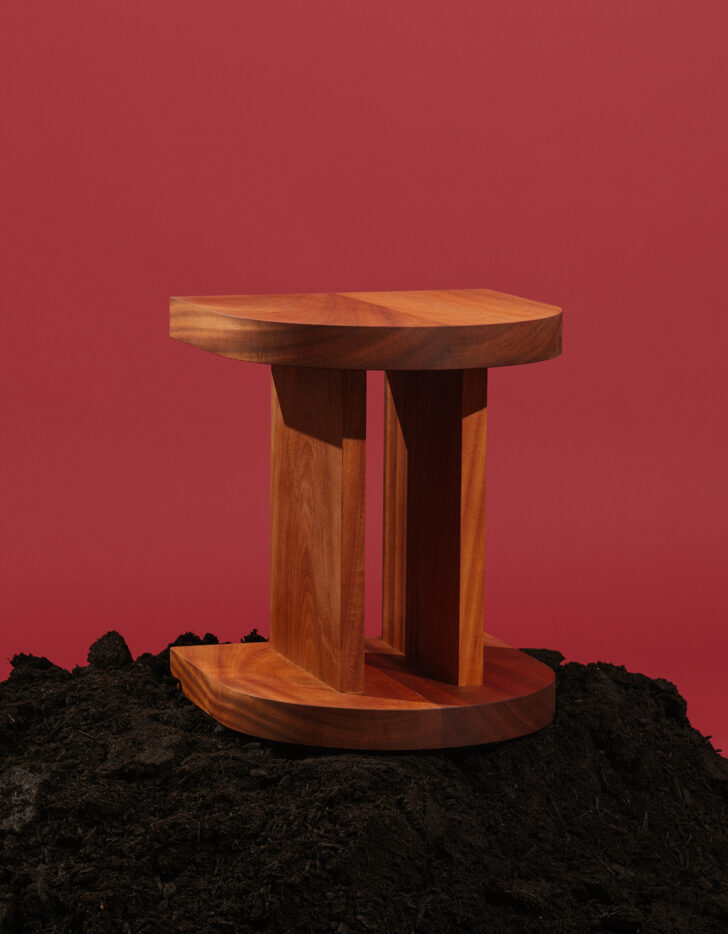
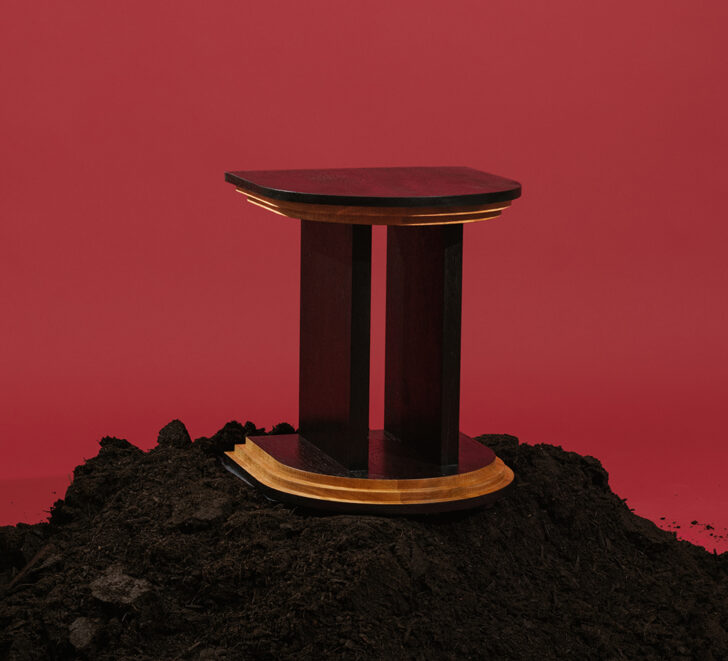
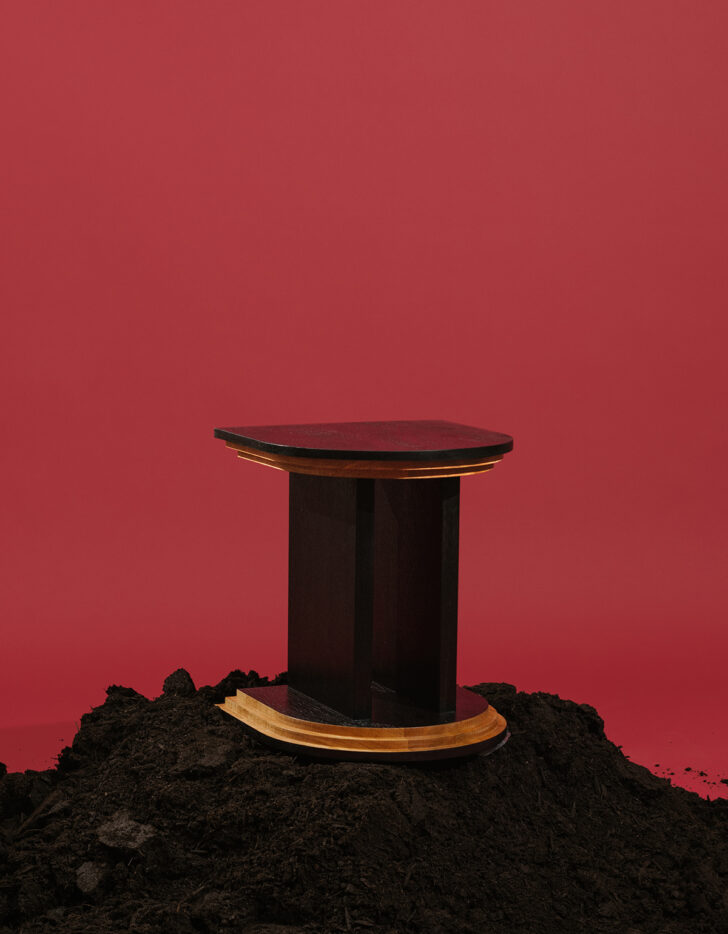
What’s next for you?
Vince: Our friends are opening a bar in Bed-Stuy, a queer cocktail bar called Singers. We just finished the bar shelves for that. All our friends have contributed to that project in one way or another and it’s nice to see it come to fruition. But this summer, and maybe a little bit into the fall, we’re switching gears and working on some larger, more architectural projects with another couple of friends who we met through David, Bond Architecture. We really hit it off. We’re making this beautiful built-in bedroom for them that will be this whole self-contained unit within an apartment. Then, hopefully, a couple more really big console pieces. It will be nice to have this change of pace away from smaller pieces to thinking more architecturally.
Mischa: Oh, and our friends, part of our distributed network of creatives, run a luxury bag brand and we’re collaborating on a line of wooden leather goods with them. That’s sort of small tabletop goods that we started talking about a year ago and are really excited to put out. So really big scale and really small scale is the near future for us, but we would like to keep putting out collections semi-regularly that build on what we’ve been doing here.
Vince: Oh yeah. I’m not anywhere close to done. [Laughs].
Do you like that collaborative aspect of working with Singers or working with Bond?
Vince: It’s really nice to feel like you have collaborators. After many years of working in the art world where the paradigm really is like one person making one thing, this feels so much more generative as a way of working, to be able to bring other people in and get expertise from other people and create things together.
Mischa: It just feels so gratifying and also creatively engaging.
Vince: Oh, and another gallery has a show coming up in September, a friend of ours is making a bunch of really large sculptural works, but he felt kind of bored at the idea of really basic plinths for the sculptures, so we’re collaborating on some tables that exist more in conversation with the sculpture to support them, that are part of the piece. Like, what is the creative thesis of this work? How do you see the table in relation to it? We try to respond to that. So, instead of, I need my five-year-old to not stub his toe on it, it’s like, I need to communicate something about web psychology in 2005, which is a little more fun.
Is there anything else we haven’t talked about that’s integral to this collection, or to your practice?
Vince: [To Mischa] How do you think it relates to transition?
Mischa: I think that’s actually a big part of it. I think my transition…a lot of it is like a material framework for processing my discomfort in material reality as something that exists as a ritual practice that I can engage in to reinforce myself and the immateriality of my body. And sometimes, this feels like another way to move tangentially to material reality, to pull out forcefully, hand over hand, something that is different or orthogonal, like a space for me to inhabit. Someone pointed out that the work feels like it has a lot of soul in it. And it’s true. There’s a not insubstantial amount of both of our blood and sweat and soul [in the work] and we pulled those out to make this space for ourselves. It’s like a deeply, deeply personal thing that is shared with others.
